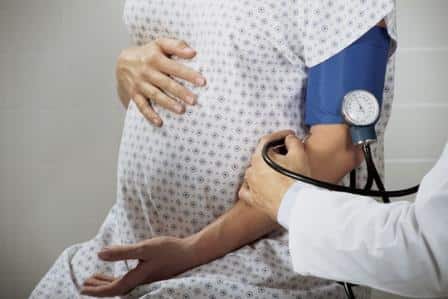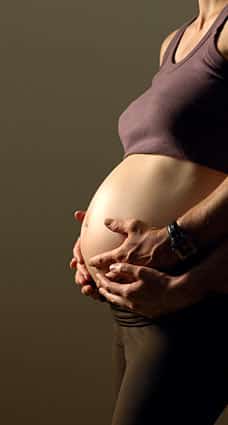Pre-eclampsia and eclampsia are disorders in pregnant women. Pre- eclampsia is hypertension and eclampsia is the worsening of pre-eclampsia where the woman experiences convulsions or goes into a coma. The complication of eclampsia in a pregnant woman can put her and her unborn child at risk. A risk that may be fatal. This is only to briefly define the disorders.
To give a complete definition of eclampsia we must define pre-eclampsia. Pre-eclampsia does not have chronic hypertension but becomes  hypertensive in late pregnancy. With pre-eclampsia a woman doesn’t experience a coma or convulsions, her blood pressure returns to normal after delivery. Although the majority of women who experience pre-eclampsia never get eclampsia-if the blood pressure gets out of hand suddenly, the disease may progress to eclampsia. Eclampsia is pre-eclampsia that has progressed to the point of convulsions and possible coma. Resulting in retardation for the child with lack of oxygenation and other proteins to fetus.
hypertensive in late pregnancy. With pre-eclampsia a woman doesn’t experience a coma or convulsions, her blood pressure returns to normal after delivery. Although the majority of women who experience pre-eclampsia never get eclampsia-if the blood pressure gets out of hand suddenly, the disease may progress to eclampsia. Eclampsia is pre-eclampsia that has progressed to the point of convulsions and possible coma. Resulting in retardation for the child with lack of oxygenation and other proteins to fetus.
A term that must be known is chronic hypertension due to increased pressure in the arteries and often associated with atherosclerosis (collections of fatty substances on the inside wall of the arteries). It is not caused by pregnancy, but may cause problems if a woman with chronic hypertension becomes pregnant. It has an unknown cause. 15% of the time chronic hypertension is secondary to a primary problem-that is a renal disorder, heart disease, endocrine disorder or some other condition is the cause of the hypertensive disease. Women with chronic hypertension who become pregnant are in high risk. Because of arterial narrowing the blood supply to the uterus is compromised and growth and oxygenation of the fetus are jeopardized. Pre-eclampsia and eclampsia are also likely to develop, with characteristic tissue swelling and proteinuria. In extreme full flown eclampsia (convulsions or coma) may occur. Women with chronic hypertension are at higher risk for fetal growth retardation, stillbirth and 4 to 5 greater risk for placental abruption. About 15% of women with chronic hypertension with experience pre-eclampsia next to their usual chronic hypertension.
To show how eclampsia is related to physics we must look at the fact that eclampsia primarily comes about from hypertension. The swelling occurs: when there is high quantity of sodium; H2O is attracted into the veins. The walls of the veins are permeable to H2O at this point, starving the rest of the cells of the body from water that later leads to seizures, weakening the brain cells.(Just one example) When there are weak cells the functions of the body seem to break down, affecting not only the mother, but the fetus as well.
Hypertension forms like this: there is direct proportion between pressure and volume–when there is a large volume there will high pressure. In relation to physics we have to speak of Fluids In Motion. We must picture fluid in a tube: when there is a certain amount of volume going through a tube it’s going at a constant, if the volume increases the flow will be more rapid because the center of the diameter is less than that at either end– according to Bernoulli’s Principle. Going back to eclampsia or pre-eclampsia we could see this example when the volume of the blood increases, because of sodium and attraction of water and so does the pressure. The speed of the blood decreases and that’s when the body looses oxygen and cells die because the supplements don’t arrive as needed causing the systems to break down. There is a cycle when pressure in the body is not at a normal, it goes from the heart not working hard enough and the brain begins to die. (another subject) In a Venturi meter we could calculate the speed of a fluid in the horizontal tube from the difference in pressure in the vertical tubes. Where the speed of the fluid is lower the pressure is higher; where the speed of the fluid is higher the pressure is lower. Kinetic energy plays a role; where the speed of the fluid increases and so does its kinetic energy.
Many women don’t realize that pre-eclampsia can also begin during labor or after deliver (one third of pre-eclampsia is manifested before  labor, one third of cases occur during and another one third take place during deliver). After hearing the physiological theories behind high blood pressure, we get into the symptoms. For pre-eclampsia the symptoms are high blood pressure or swelling with rapid of weight gain, headaches, nervousness, intermittent blurred vision and undue fatigue. These are reasons why blood pressure and weight and a urinalysis are performed at each prenatal visit is to make sure pre-eclampsia is not developing. Many of the symptoms are normal during pregnancy. The real tests are blood pressure and the absence or presence of protein in the urine.
labor, one third of cases occur during and another one third take place during deliver). After hearing the physiological theories behind high blood pressure, we get into the symptoms. For pre-eclampsia the symptoms are high blood pressure or swelling with rapid of weight gain, headaches, nervousness, intermittent blurred vision and undue fatigue. These are reasons why blood pressure and weight and a urinalysis are performed at each prenatal visit is to make sure pre-eclampsia is not developing. Many of the symptoms are normal during pregnancy. The real tests are blood pressure and the absence or presence of protein in the urine.
In eclampsia it’s more severe; from convulsions to coma. There is blindness, brain hemorrhaging, renal failure, hypertension and arrhythmia; the damages are permanent that leave the mother having to change her life style after the delivery of her child. As with pre-eclampsia, eclampsia can affect every organ and body system, causing either permanent damage or death of the mother and baby if not vigorously managed.
Preventive measures start with exercise and diet and frequent check-ups if not hospitalized. In recent study a preventive measure for pre-eclampsia was immunological intercourse. It is suggested that by increasing the duration of sexual cohabitation before the first pregnancy with partner. It has been observed that repeated exposure to male sperm may prevent pre-eclampsia. In the study of 83 pre-eclamptics it had an average of 59.4 physiological exposures to sperm but the non pre-eclamptics control group of 55 had 191.6 exposures. A permanent cure is delivering the child and following up on both. Some medications that are for convulsions are magnesium sulphate, diazepam, phenytoin (magnesium sulphate being superior); all given intravenously. Magnesium sulphate diminishes the risk of further nonfatal morbidity than other agents. It is far better than phenytoin in preventing convulsions for hypertensive pregnant women, according to The Must-Read Trial.
Eclampsia is a problem in undeveloped countries. It is relatively uncommon in developed counties where it complicated about one in every 2000 deliveries. Eclampsia can be 20 times more common in developing countries, and it probably accounts for more than 50000 maternal deaths worldwide each year. Here in the United Stated prenatal care is to prevent pre-eclampsia. That has been going on since 1961. Hypertension alone is a problem in 80% of the world population. Eclampsia is a disorder better prevented that cured.
